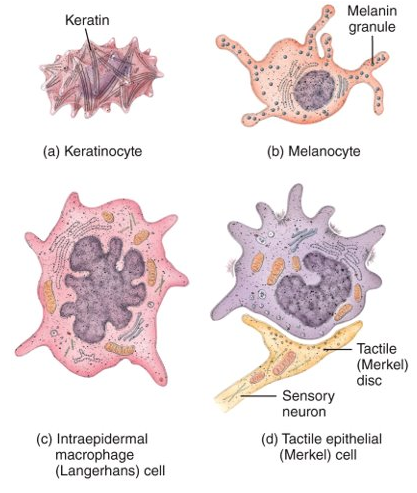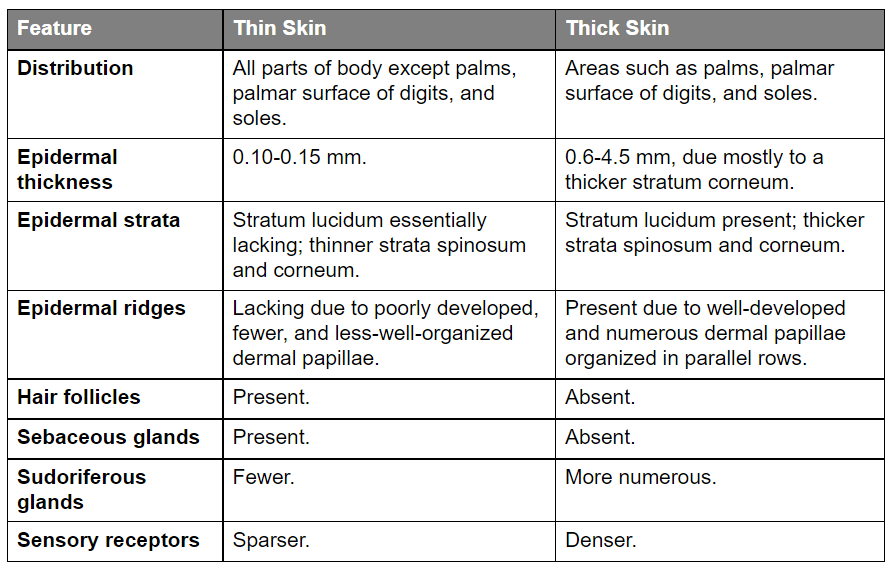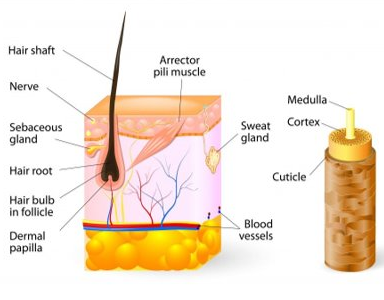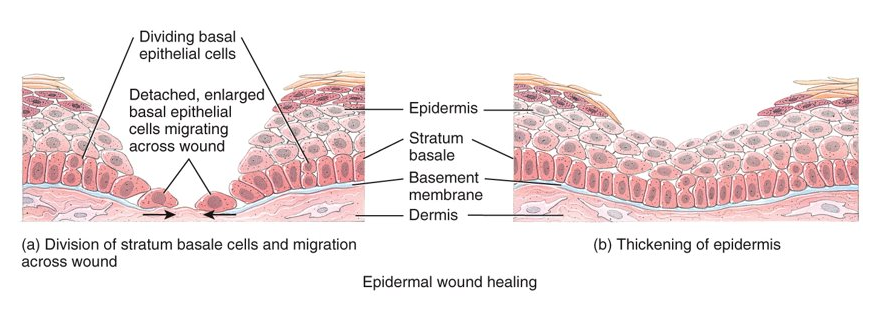Human Anatomy: Chapter 5
5.0(1)
Card Sorting
1/44
Earn XP
Description and Tags
Study Analytics
Name | Mastery | Learn | Test | Matching | Spaced |
|---|
No study sessions yet.
45 Terms
1
New cards
What is the largest organ of the body?
skin
2
New cards
What is the two structural parts of the skin?
epidermis and dermis

3
New cards
What is the epidermis made of?
keratinized stratified squamous epithelial tissue
4
New cards
What is the dermis made of?
connective tissue
5
New cards
What is the hypodermis/subcutaneous layer?
it is not part of the skin; areolar and adipose tissue; serves as fat storage, blood vessel passage, and nerve endings
6
New cards
What are the four types of cells in the epidermis?
keratinocytes, intraepidermal macrophages/langerhans cells, melanocytes, and tactile epithelial cells

7
New cards
What are keratinocytes?
produce the protein keratin, which helps protect the skin and underlying tissue from heat, microbes, and chemicals, and lamellar granules, which release a waterproof sealant
8
New cards
What are melanocytes?
produce the pigment melanin which contributes to skin color and absorbs damaging UV light
9
New cards
What are intraepidermal macrophages/langerhans cells?
immune responses
10
New cards
What are tactile epithelial cells/merkel cells
contact a tactile/merkel disc and sense touch
11
New cards
What are the four/five layers of the epidermis from deep to superficial?
stratum basale, stratum spinosum, stratum granulosum, stratum lucidum (only in thick skin), stratum corneum
12
New cards
What is the basale layer?
deepest layer; single row of cuboidal or columnar keratinocytes; stem cells undergo cell division to produce new keratinocytes here; melanocytes and tactile epithelial cells with tactile discs here
13
New cards
What is the corneum layer?
50 or more rows of dead, flat keratinocytes made of mainly keratin
14
New cards
What is keratinization?
replacement of cell contents with the protein keratin, occurs as cells move to the skin surface over 2-4 weeks
15
New cards
What are the two types of skin?
thin (hairy) skin (everywhere but palms and soles) and thick (hairless) skin (only on palms and soles)

16
New cards
What are the two regions of the dermis?
papillary and reticular
17
New cards
What is the papillary?
superficial; areolar connective tissue with thin collagen and fine elastic fibres; dermal ridges that house blood capillaries, tactile corpuscles, and free nerve endings
18
New cards
What is the reticular?
deep; dense irregular connective tissue with bundles of thick collagen and some coarse elastic fibres; adipose cells, hair follicles, nerves, sebaceous glands, and sudoriferous glands
19
New cards
What is melanin?
produced by melanocytes in the basale
20
New cards
What are the three types of melanin?
pheomelanin (yellow-red), eumelanin (brown-black), and freckles (patches of melanin)
21
New cards
What is hemoglobin?
red pigment of RBCs
22
New cards
What is carotene?
yellow-orange pigment in stratum corneum and adipose tissue
23
New cards
What is albinism?
congenital disorder that causes complete or partial absence of pigment in the skin, hair, and eyes due to a defect of an enzyme involved in the production of melanin
24
New cards
What is vitiligo?
a chronic disorder that causes depigmentation patches in the skin, unknown cause
25
New cards
What is hair made of?
dead, keratinized epidermal cells
26
New cards
What are the parts of the hair?
the shaft (above the skin), cuticle, the follicle (below the skin), and the root (dermis and subcutaneous)

27
New cards
What are the three growth stages of hair and what happens during them?
growth stage: cells divide, hair grows longer
regression stage: cell division and growth stops, follicle atrophies
resting stage: hair root falls out of the follicle
regression stage: cell division and growth stops, follicle atrophies
resting stage: hair root falls out of the follicle
28
New cards
What is lanugo hair?
fine, nonpigmented, downy hair that covers the fetus
29
New cards
What is vellus hair?
short, fine, pale hair; “peach fuzz”
30
New cards
What is terminal hair?
long, coarse, pigmented hair; hair of the head, eyelashes and eyebrows; increase in response to androgens
31
New cards
What determines hair colour?
amount and type of melanin
32
New cards
What is the function of hair?
protection, decrease in heat loss, and sensing light touch
33
New cards
What are the three types of skin glands and their function?
sebaceous (oil): connected to hair follicles
sudoriferous (sweat): help to regulate body temperature and eliminate wastes
ceruminous: modified sweat glands that produce called cerumen in the ear canal
sudoriferous (sweat): help to regulate body temperature and eliminate wastes
ceruminous: modified sweat glands that produce called cerumen in the ear canal
34
New cards
What are nails?
keratinized epidermal cells over the dorsal surfaces of the terminal portions of the fingers and toes

35
New cards
What are the functions of skin?
thermoregulation, blood reservoir (8-10%), protection, cutaneous sensations, excretion and absorption, synthesis of vitamin D
36
New cards
What are the six specific cells and secretions used in protection of the skin?
keratin: protects tissues
lipids: guards against dehydration
sebum: kills bacteria and prevents skin/hairs from drying out
acidic sweat: decreases bacterial growth
melanin: UV protection
macrophages: immune protection
lipids: guards against dehydration
sebum: kills bacteria and prevents skin/hairs from drying out
acidic sweat: decreases bacterial growth
melanin: UV protection
macrophages: immune protection
37
New cards
How is vitamin D synthesized?
requires activation of a precursor molecule in the skin by UV light, with enzymes in the liver and kidneys modifying the activated molecule to produce calcitriol
38
New cards
What are epidermal wounds?
the central portion of the wound usually extends deep down to the dermis, whereas the wound edges usually involve only superficial damage to the epidermal cells; repaired by enlargement and migration of basal cells, contact inhibition, and division of migrating and stationary basal cells; epidermal growth factor stimulates basal cells to divide and replace the ones that have moved into the wound

39
New cards
What are the four steps to deep wound healing and explain each?
inflammatory phase: a blood clot unites the wound edges, epithelial cells migrate across the wound, vasodilation and increased permeability of blood vessels deliver phagocytes, and fibroblasts form
migratory phase: epithelial cells beneath the scab bridge the wound, fibroblasts begin scar tissue, and damaged blood vessels begin to grow, tissue filling the wound is called granulation tissue
proliferative phase: events of the migratory phase intensify
maturation phase: the scab sloughs off, the epidermis is restored to normal thickness, collagen fibers become more organized, fibroblasts begin to disappear, and blood vessels are restored to normal, fibrosis can occur in deep wound healing
migratory phase: epithelial cells beneath the scab bridge the wound, fibroblasts begin scar tissue, and damaged blood vessels begin to grow, tissue filling the wound is called granulation tissue
proliferative phase: events of the migratory phase intensify
maturation phase: the scab sloughs off, the epidermis is restored to normal thickness, collagen fibers become more organized, fibroblasts begin to disappear, and blood vessels are restored to normal, fibrosis can occur in deep wound healing
40
New cards
What age does the most effects of aging on the skin occur and what are some of them?
late forties; wrinkling, slow hair and nail growth, dryness and cracking, gray hair, decreased immune responsiveness, loss of subcutaneous fat and thinner skin, sweat production decrease, nails become more brittle
41
New cards
How does the integumentary system help all the other body systems?
skeletal: helps with vit. D production
muscular: provides calcium ions
nervous: input to brain
endocrine: vit. D converted to calcitriol
cardiovascular: vasodilation and vasoconstriction
lymphatic: first line of defense
respiratory: remove dust particles
digestive: promotes absorption of calcium
urinary: waste products excreted through sweat
reproductive: respond to erotic pleasure
muscular: provides calcium ions
nervous: input to brain
endocrine: vit. D converted to calcitriol
cardiovascular: vasodilation and vasoconstriction
lymphatic: first line of defense
respiratory: remove dust particles
digestive: promotes absorption of calcium
urinary: waste products excreted through sweat
reproductive: respond to erotic pleasure
42
New cards
What are the three major types of skin cancer?
basal cell carcinoma, squamous cell carcinoma, and malignant melanoma
43
New cards
What is a burn?
tissue damage caused by excessive heat, electricity, radioactivity, or corrosive chemicals that break down the proteins in the skin cells; the systemic effects of a burn are a greater threat to life than are the local effects
44
New cards
What is the rule of nines
used to estimate the surface area of an adult affected by a burn
45
New cards
What is a pressure ulcer?
a constant deficiency of blood to tissues overlying a bony projection that has been subjected to prolonged pressure against an object such as a bed, cast, or splint